Zora Neale Hurston in Brevard County
FHS has a traveling exhibit for Zora Neale Hurston in Brevard County.


Teacher's Curriculum Guide for:
Zora Neale Hurston in Brevard County, FL
 Select for more about Panel1 |
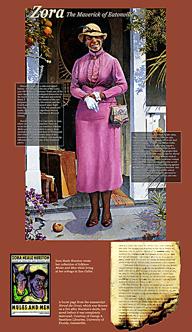 Select for more about Panel 2 |
 Select for more about Panel 3 |
 Select for more about Panel 4 |
PDFfile:
Curriculum Guide for Zora Neale Hurston in Brevard County, FL
Teacher's Curriculum Guide for Zora Neale Hurston in Brevard County, FL in pdf format that can be downloaded here or viewed in the below frame on this page if your web browser supports embedded pdf.
Panel 1, Zora Neal Hurston in Brevard County
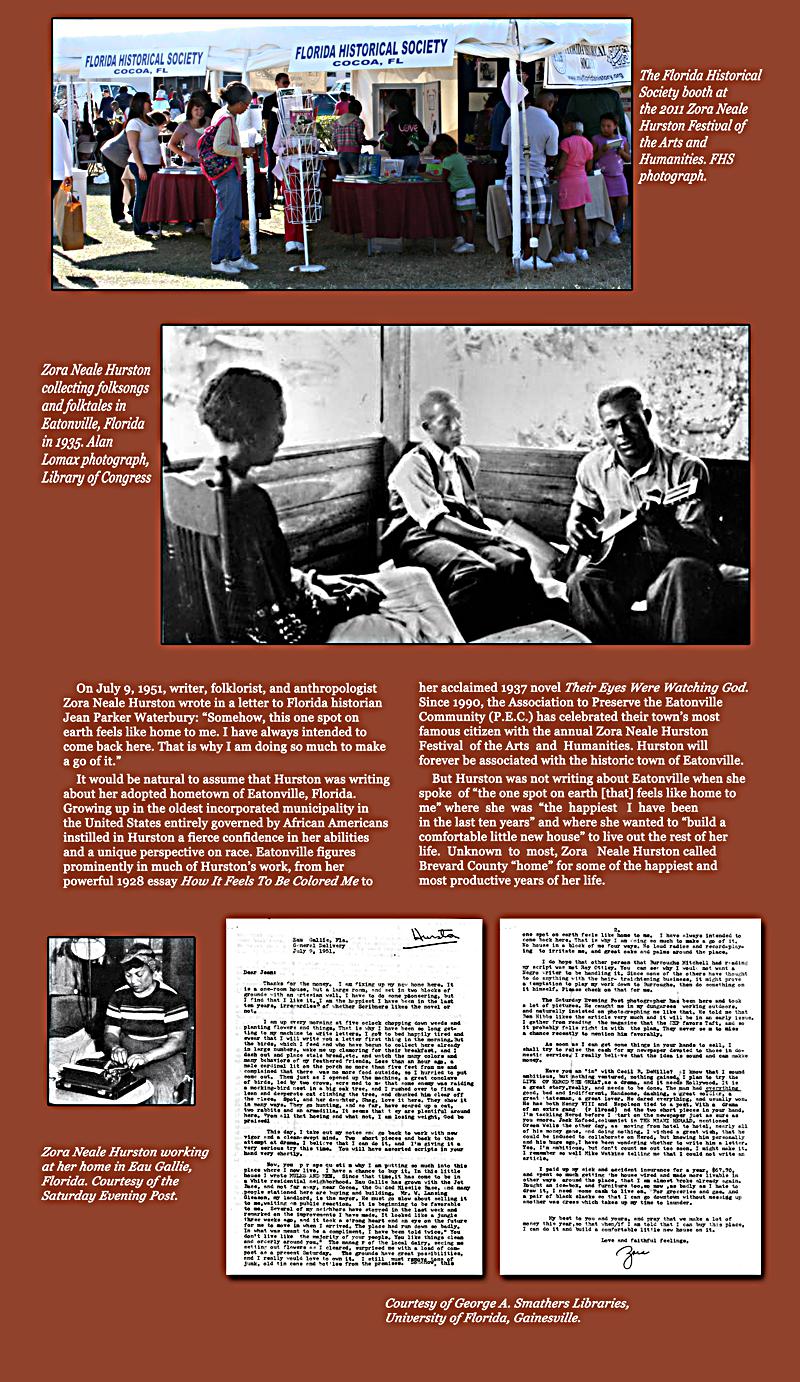
On July 9, 1951, writer, folklorist, and anthropologist Zora Neale Hurston wrote in a letter to Florida historian Jean Parker Waterbury: “Somehow, this one spot on earth feels like home to me. I have always intended to come back here. That is why I am doing so much to make a go of it.”
It would be natural to assume that Hurston was writing about her adopted hometown of Eatonville, Florida. Growing up in the oldest incorporated municipality in the United States entirely governed by African Americans instilled in Hurston a fierce confidence in her abilities and a unique perspective on race. Eatonville figures prominently in much of Hurston’s work, from her powerful 1928 essay How It Feels To Be Colored Me to her acclaimed 1937 novel Their Eyes Were Watching God. Since 1990, the Association to Preserve the Eatonville Community (P.E.C.) has celebrated their town’s most famous citizen with the annual Zora Neale Hurston Festival of the Arts and Humanities. Hurston will forever be associated with the historic town of Eatonville.
But Hurston was not writing about Eatonville when she spoke of “the one spot on earth [that] feels like home to me” where she was “the happiest I have been in the last ten years” and where she wanted to “build a comfortable little new house” to live out the rest of her life.
Unknown to most, Zora Neale Hurston called Brevard County “home” for some of the happiest and most productive years of her life.
Panel 2, Zora Neal Hurston in Brevard County
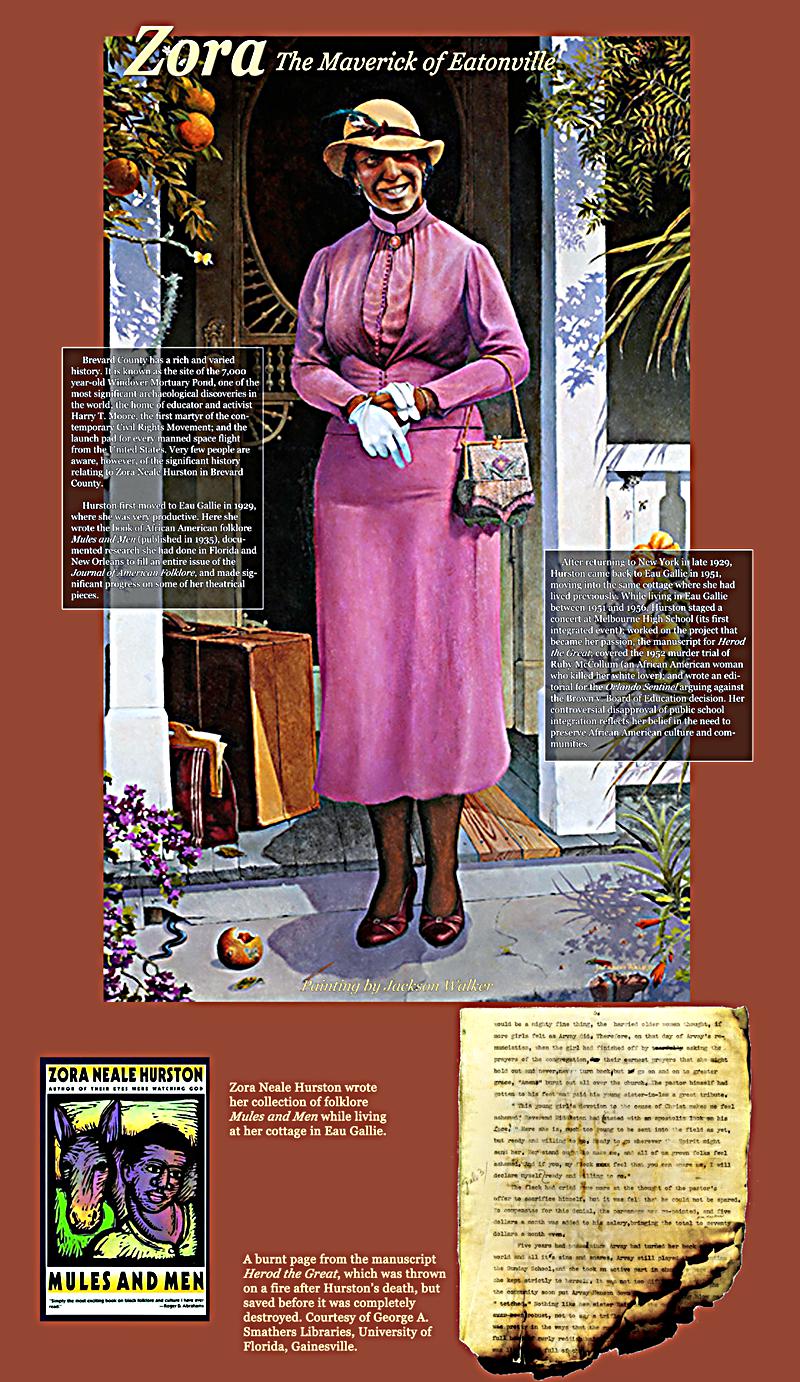
Brevard County has a rich and varied history. It is known as the site of the 7,000 year-old Windover Mortuary Pond, one of the most significant archaeological discoveries in the world; the home of educator and activist Harry T. Moore, the first martyr of the contemporary Civil Rights Movement; and the launch pad for every manned space flight from the United States. Very few people are aware, however, of the significant history relating to Zora Neale Hurston in Brevard County.
Hurston first moved to Eau Gallie in 1929, where she was very productive. Here she wrote the book of African American folklore Mules and Men (published in 1935), documented research she had done in Florida and New Orleans to fill an entire issue of the Journal of American Folklore, and made significant progress on some of her theatrical pieces.
After returning to New York in late 1929, Hurston came back to Eau Gallie in 1951, moving into the same cottage where she had lived previously. While living in Eau Gallie between 1951 and 1956, Hurston staged a concert at Melbourne High School (its first integrated event); worked on the project that became her passion, the manuscript for Herod the Great; covered the 1952 murder trial of Ruby McCollum (an African American woman who killed her white lover); and wrote an editorial for the Orlando Sentinel arguing against the Brown v. Board of Education decision. Her controversial disapproval of public school integration reflects her belief in the need to preserve African American culture and communities.
Panel 3, Zora Neal Hurston in Brevard County
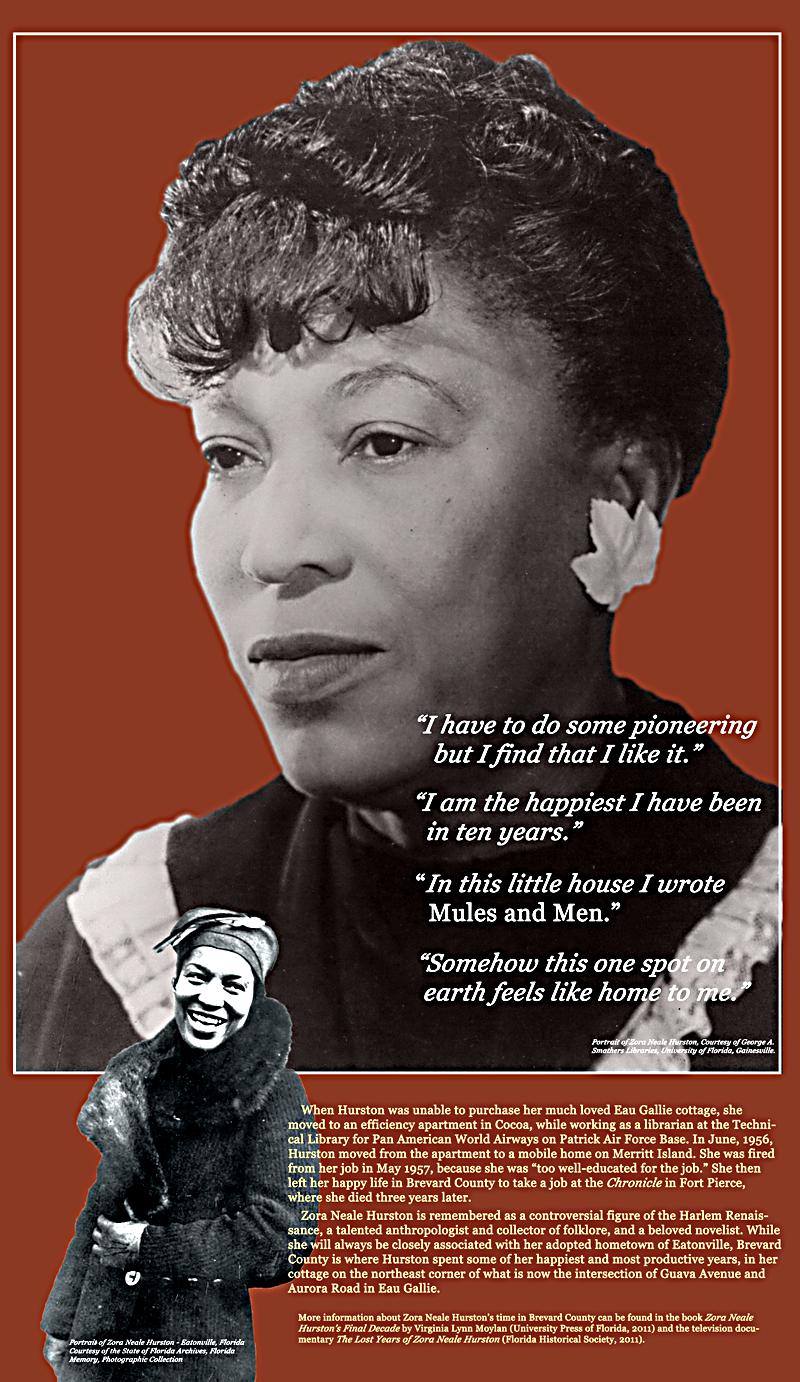
When Hurston was unable to purchase her much loved Eau Gallie cottage, she moved to an efficiency apartment in Cocoa, while working as a librarian at the Technical Library for Pan American World Airways on Patrick Air Force Base. In June, 1956, Hurston moved from the apartment to a mobile home on Merritt Island. She was fired from her job in May 1957, because she was “too well-educated for the job.” She then left her happy life in Brevard County to take a job at the Chronicle in Fort Pierce, where she died three years later.
Zora Neale Hurston is remembered as a controversial figure of the Harlem Renaissance, a talented anthropologist and collector of folklore, and a beloved novelist. While she will always be closely associated with her adopted hometown of Eatonville, Brevard County is where Hurston spent some of her happiest and most productive years, in her cottage on the northeast corner of what is now the intersection of Guava Avenue and Aurora Road in Eau Gallie.
More information about Zora Neale Hurston’s time in Brevard County can be found in the book Zora Neale Hurston’s Final Decade by Virginia Lynn Moylan (University Press of Florida, 2011) and the television documentary The Lost Years of Zora Neale Hurston (Florida Historical Society, 2011).
Panel 4, Zora Neal Hurston in Brevard County
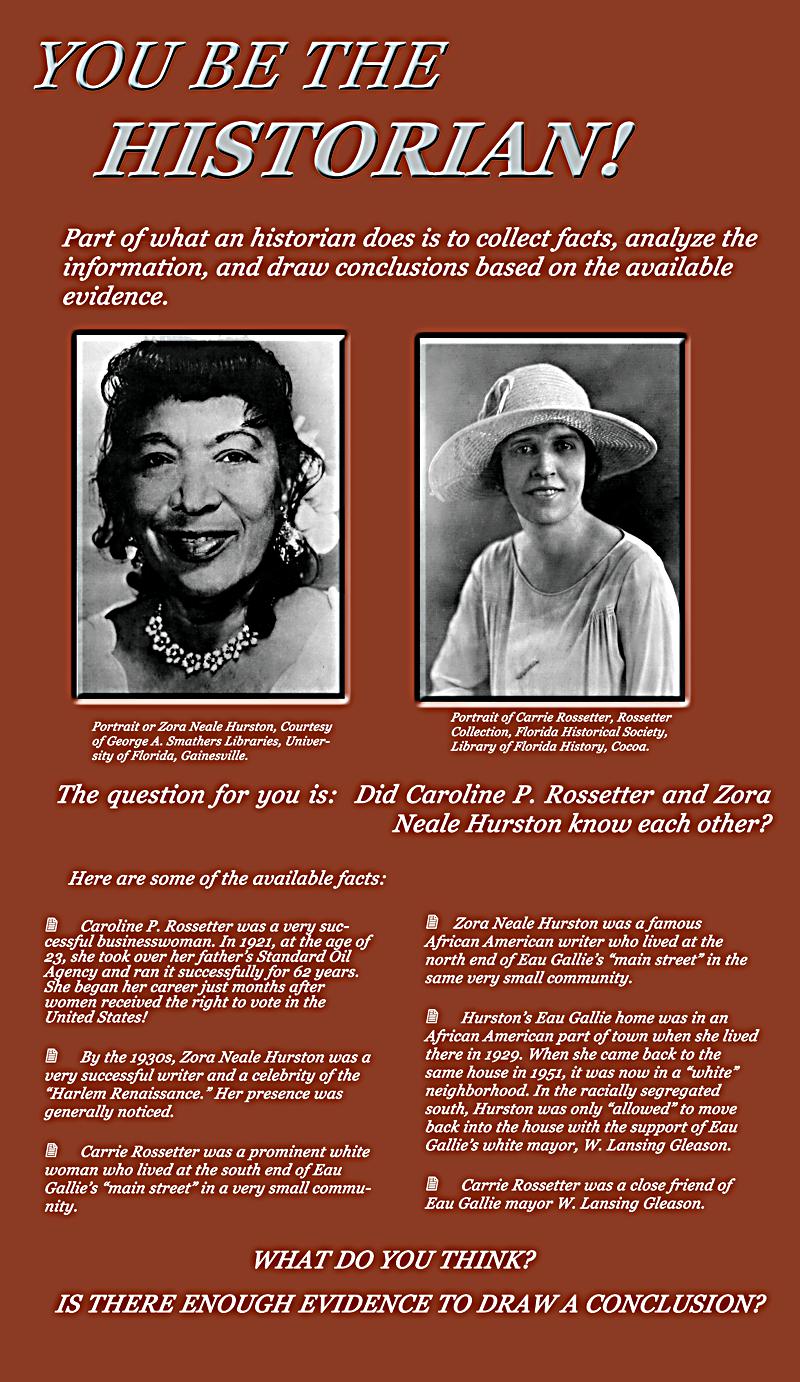
YOU BE THE HISTORIAN!
Part of what an historian does is to collect facts, analyze the information, and draw conclusions based on the available evidence.
The question for you is: Did Caroline P. Rossetter and Zora Neale Hurston know each other?
Here are some of the available facts:
- Caroline P. Rossetter was a very successful businesswoman. In 1921, at the age of 23, she took over her father’s Standard Oil Agency and ran it successfully for 62 years. She began her career just months after women received the right to vote in the United States!
- By the 1930s, Zora Neale Hurston was a very successful writer and a celebrity of the “Harlem Renaissance.” Her presence was generally noticed.
- Carrie Rossetter was a prominent white woman who lived at the south end of Eau Gallie’s “main street” in a very small community.
- Zora Neale Hurston was a famous African American writer who lived at the north end of Eau Gallie’s “main street” in the same very small community.
- Hurston’s Eau Gallie home was in an African American part of town when she lived there in 1929. When she came back to the same house in 1951, it was now in a “white” neighborhood. In the racially segregated south, Hurston was only “allowed” to move back into the house with the support of Eau Gallie’s white mayor, W. Lansing Gleason.
- Carrie Rossetter was a close friend of Eau Gallie mayor W. Lansing Gleason.
WHAT DO YOU THINK? IS THERE ENOUGH EVIDENCE TO DRAW A CONCLUSION?